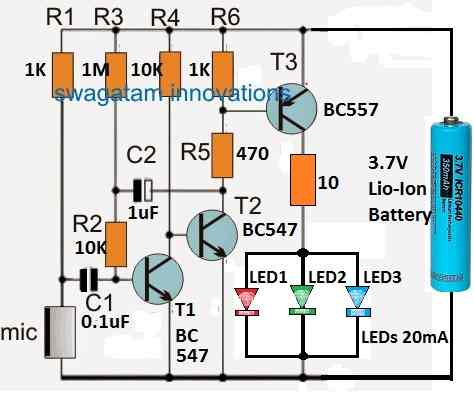In this article I have explained how to build an LED bow tie circuit which will activate and blink a few LED lights stuck on your bow tie in response to your voice sound. It means, the LED lights on your bow tie will flash and blink, whenever you speak, creating a very eye catching effect on your bow tie.

Circuit Diagram

Parts List
- Resistors 1/4 watt CFR unless specified
- 1K = 2
- 10k = 2
- 1M = 1
- 470 Ohms = 1
- 10 Ohms = 1
- Capacitors
- 0.1uF Ceramic = 1
- 1uF/25V Electrolytic = 1
- Transistor BC547 = 2
- Transistor BC557 = 1
- LEDs = Quantity as Required, 20 mA, 5mm type
- Electret MIC = 1
- Battery 3.7 V = 1
Circuit Description
The following points can be used to understand how the bow tie LED light circuit operates, with reference to the circuit schematic above.
As a whole, resistors R1, R2, and R3 and transistor T1 work like a basic electret MIC preamplifier circuit.
This stage's primary job is to increase the MIC's tiny electrical pulses into comparatively bigger voltage pulses.
The resistors R4, R5, and R6, in conjunction with transistors T2 and T3, are set up to function as a power amplifier.
This power amplifier's function is to greatly increase the voltage and current output from the preamplified pulses at T1's collector.
At the collector of transistor T3, the set of 3 LEDs is eventually driven and illuminated by this increased voltage and current.
To provide the LEDs a delay OFF function, resistor R3 and capacitor C2 are utilized. This makes sure that even when the sound vibrations on the MIC stop, the LEDs continue to glow for a few seconds.
The delay OFF timing of the LED switch OFF period may be adjusted by increasing or decreasing the C2 value.
Formula for the delay off timing is:
where:
tis the delay time in secondsRis the resistance in ohmsCis the capacitance in faradsVCis the voltage across the capacitor at which the timer turns offVSis the supply voltage
In order to enhance the battery efficiency you can completely eliminate this delay off feature by removing the C2 capacitor from the circuit.
The R1 resistor's value may be altered to change the circuit's sensitivity. Sensitivity is reduced as the value is increased, and vice versa.
Battery Selection
The battery can be any Li-ion AAA 3.7V type, or if you want it to be even more compact, you can use two Li-ion 3V coin cells, attached in series.
Since the LEDs would activate only in response to voice sounds, most of the time the circuit will be inactivate allowing a long life for the battery.
When the battery gets discharged you can charge them using a cell phone charger, but make sure to use a 6V incandescent flashlight lamp in series. If you don't have the lamp, you can use a 50 ohm 1 watt resistor in series.
LED Selection
The LEDs can be of different colors, all high bright 3.3 V, 20 mA type. You can put around 3 to 6 LEDs in parallel as shown in the diagram.
Need Help? Please Leave a Comment! We value your input—Kindly keep it relevant to the above topic!